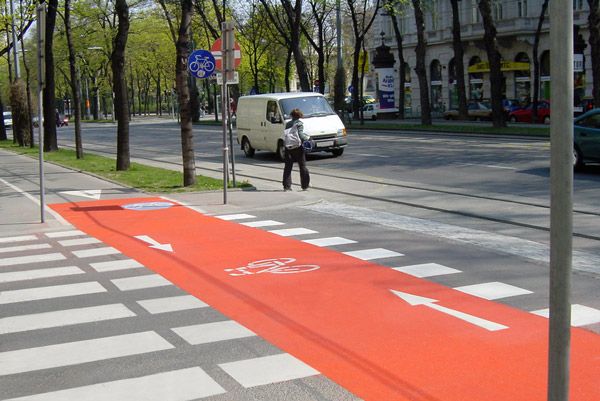Bicycle Lanes: a Growing Focus on Safety
Cycling is more popular than ever. But this comes along with an increasing number of severe accidents. Protective markings can minimize this risk considerably.
There are one billion bicycles in use on the planet. And unfortunately, thousands of cyclists die in accidents every year. Cycling accidents are also disproportionately fatal, and often involve children. This curbs the enthusiasm for this healthy, environmentally friendly means of transport. However, setting up highly visible bicycle lanes can make significant improvements to cycling safety. Visually conspicuous road markings play a key role in this respect. SWARCO Road Marking Systems is one of the global players in research and development in this field.

Visually conspicuous markings make bicycle lanes safer. In this area, too, SWARCO Road Marking Systems’ solutions ensure greater safety in road traffic.
23 March 2021 – “Bicycle lanes make our environment more liveable. They require far less space than roads and they do not generate noise or pollution, which greatly contributes to healthy populations overall. However, optimizing safety remains a challenge, especially for bicycle lanes which are directly adjacent to lanes for motorized traffic. Clearly visible markings and colour separations are ways to minimize risks,” Andreas Nagel, Product and Sales Consultant at SWARCO Road Marking Systems, explains.
The cycling boom continues unabated. This healthy, climate-friendly means of transport is particularly popular for distances up to 10 kilometres. This means that up to 30% of the traffic volume in densely populated areas could be replaced by cycling. As for the fact that cyclists are more likely to be involved in serious accidents than motorists, it very often has to do with inadequate infrastructure.
Safety on Bicycle Lanes
“Unlike car users, cyclists do not have a protective shell around them. For this reason, bicycle lanes must offer them greater protection. Coloured bicycle lanes, combined with white symbols and directional arrows, for instance, are an effective way of calming traffic,” Andreas Nagel explains. They let cyclists use the roads, too. Colour contrasting to separate bicycle lanes from motorized traffic increases recognition, and prompts motorists to reduce their speed. “Across the globe, SWARCO Road Marking Systems implements tried and tested solutions to improve safety. Visual separation also ensures that motorists and delivery personnel don’t use bicycle lanes as parking spaces or otherwise occupy them with their vehicles,” Andreas Nagel says.Global Trends: a Great Oportunity
In the current situation, social distancing has further reinforced the trend towards cycling, studies show. Cities such as New York, London, Paris, Berlin or Vienna have even installed pop-up bicycle lanes. These short-term bicycle lanes have taken part of the burden off local public transport and created more space for cyclists. “The current situation is an opportunity to rethink traffic concepts. Many people have a new-found desire for outdoor activities, which is also manifesting in day-to-day transport choices. Decision-makers should seize the opportunity of this mindset shift to make road traffic even more environmentally friendly and sound. At SWARCO Road Marking Systems, when it comes to traffic safety, we have a wide array of products,” Andreas Nagel says.Quality products and services from SWARCO Road Marking Systems guide traffic safely from A to B by day and, above all, by night. On all types of roads. Whatever the weather. From a single source. Over 5,000 customers in more than 80 countries place their trust in them.
For further information visit: www.swarco.com/solutions/road-marking-systems/cycle-path-markings
www.swarco.com/rms